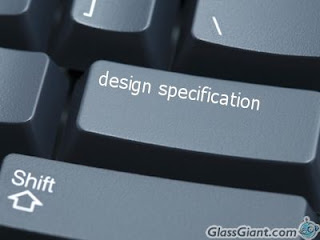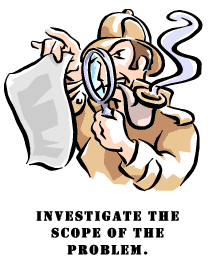Sunday, January 30, 2011
January 31, February 2
Year 8 - Now it's your turn to 3. Formulate a Design Specification
A Design Specification is a statement (list) that tells the designer exactly what the product has to do and what the design requirements are.
What kinds of Design Specifications are appropriate for a written document?
1. Let's brainstorm and you will complete your list.
2. Now, create test to evaluate your product. Remember to include a rating scale (on a scale of 1 to 10. 1=legendary, 10=lame) please answer the following questions.
Learning Objective - The Student will: understand the concept and importance of the design specification, and understand the importance of testing to determine the success of the product/solution and, with guidance, design a simple test.
Saturday, January 22, 2011
January 24, 26
Great! Year 8 - we are now onto the 2nd stage of the Investigate:
2. Develop a Design Brief
This is the section that we ask questions that will help "drive" the investigation. That is, we will create questions that you can research and the answers will give you enough information to help you solve your problem.
Aspects that we want to take into consideration are:
1). gather information on Child Labour to include in your pamphlet
- you might want to select information on several examples/countries
2). gather images for support
3). how can people help? gather information and links on organizations that help
4). research Microsoft Publisher 2010
Let's brainstorm some questions that will help you with your research;-)
THE RESEARCH QUESTIONS ARE AS FOLLOWS:
1) What information on Child Labour can I include in my tri-fold pamphlet?
2) What images are related to Child Labour and can support my information?
3) How can people help? What information and links on organizations can I find to include in my tri-fold pamphlet?
Note: please remember to include the URL's you visit;-)
Learning Objective - The student will: ask relevant questions at the different stages of the investigation; identify appropriate sources of information and acknowledge these using a recognized convention; consider, with guidance, the value of sources of information.
Sunday, January 16, 2011
January 17, 19
Year 8, First let's take a look at the handout to learn a little about the problem of child labour. (This should take 1 period).
Next, let's begin the first stage of the Investigation - 1. Identify the Problem. This is the introduction to your project. This paragraph lets the reader know what the problem is, how you are going to solve it, who your intended audience is and how it connects to "Health and Social Education". If you have any questions about how to construct your paragraph you have loads of options: 1) Look at the work you did in Term 1 and use it as a guide, 2) access the Investigate Template tab at the top of this blog, 3) ask the teacher for feedback on what you have written ;-)
Learning objective - The student will: outline a simple design brief; consider the importance of the problem for life, society and/or the environment.
Next, let's begin the first stage of the Investigation - 1. Identify the Problem. This is the introduction to your project. This paragraph lets the reader know what the problem is, how you are going to solve it, who your intended audience is and how it connects to "Health and Social Education". If you have any questions about how to construct your paragraph you have loads of options: 1) Look at the work you did in Term 1 and use it as a guide, 2) access the Investigate Template tab at the top of this blog, 3) ask the teacher for feedback on what you have written ;-)
Learning objective - The student will: outline a simple design brief; consider the importance of the problem for life, society and/or the environment.
Tuesday, January 11, 2011
January 12
Our unit question is: "How hard should children work?"
Let's take a minute and look at the Unit of Work.
Now let's explore just why this is such an important issue: Nike and Child Labor
Unicef - http://www.unicef.org/protection/index_childlabour.html
Save the Children - http://www.savethechildren.in/?pinid=97182244&gclid=COjh5p6Rs6YCFRgz3godmzH9oQ
Anti-Slavery Society - http://www.anti-slaverysociety.addr.com/toc.htm
Our task is to create a pamphlet using Publisher 2010 to raise awareness of this issue and promote change.
Sunday, January 2, 2011
January 3, 5, 6 - 2011
Welcome back Year 8. I hope you had a wonderful holiday break and are rested and ready to get down to work in 2011!
EVALUATE - Criterion E Maximum 6
1.Students are expected to evaluate the product/solution against the design specification in an objective manner based on testing, and to evaluate its impact on life, society and/or the environment. They are expected to explain how the product/solution could be improved as a result of these evaluations.
2.Students are expected to evaluate their own performance at each stage of the design cycle and to suggest ways in which their performance could be improved.
To get a 6 the student: evaluates the success opf the product/solution considering the results of testing, and the views of the user. The student evaluates their own performance at some stages of the design cycle and considers improvements. The student considers the impact of the product/solution on life, society and/or the environment.
1. Print the questionnaire (that you created in the Investigate) and show your digital story to 5 people and ask them to answer your questionnaire.
2. Write a paragraph to "analyze" the feedback. In other words write about the scores that you received and say how your digital story could be improved.
3. Evaluate your performance at each stage of the design cycle: Investigate, Design, Plan, Create AND suggest ways that you can improve your performance. (You need 4 paragraphs here).
4. Write a final paragraph saying if you accomplished your goal and what impact it will have. In other words, look at the unit question - were you successful? Explain.
Learning objectives: carry out tests to compare final product against design specification, suggest improvements, reflect on their performance and identify parts they found difficult and suggest ways in which their performance could be improved.
Subscribe to:
Posts (Atom)




